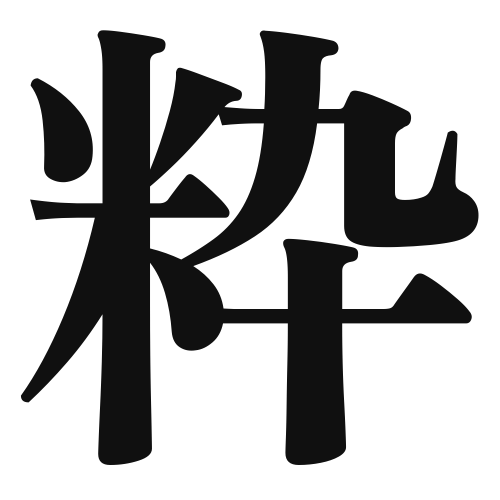1. Overview of Meaning
The kanji “粋” (pronounced “sui”) generally means “stylish,” “refined,” or “elegant.” It conveys a sense of sophistication and a deep appreciation for beauty in simplicity.
2. Formation and Radical
Formation of the Kanji: The kanji “粋” is a compound character (会意文字) that combines the elements of “米” (rice) and “行” (to go). This combination suggests the idea of something pure and essential, much like the essence of rice in Japanese culture.
Radical: The radical for “粋” is “米,” which relates to rice, a staple food in Japan, symbolizing purity and quality.
3. Examples of Usage
Common Words and Phrases:
- 粋な人 (sui na hito) – a stylish person
- 粋なデザイン (sui na dezain) – a refined design
Example Sentences in Daily Conversation:
- 彼はいつも粋な服を着ています。 (Kare wa itsumo sui na fuku o kiteimasu.) – He always wears stylish clothes.
- このレストランは粋な雰囲気があります。 (Kono resutoran wa sui na fun’iki ga arimasu.) – This restaurant has a refined atmosphere.
4. Synonyms and Antonyms
Similar Kanji:
- 洗練 (senren) – refinement, which emphasizes the process of becoming elegant or sophisticated.
- 優雅 (yūga) – elegance, which focuses more on gracefulness.
Antonyms:
- 粗野 (soya) – rough or uncouth, which represents a lack of refinement.
- 下品 (gehin) – vulgar, which indicates a lack of taste or sophistication.
5. Cultural and Historical Background
Connection to Japanese Culture: The concept of “粋” is deeply embedded in Japanese aesthetics, particularly in traditional arts such as tea ceremonies, kimono fashion, and calligraphy, where simplicity and elegance are highly valued.
Proverbs and Idioms:
- 粋な計らい (sui na hakarai) – a stylish arrangement, often used to describe thoughtful gestures that reflect elegance.
- 粋を尽くす (sui o tsukusu) – to go all out in style, indicating a commitment to elegance in one’s actions.
